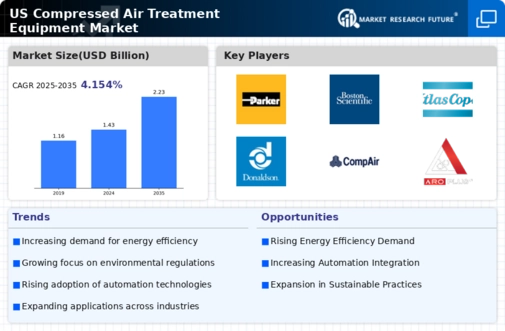Rising Energy Costs
The escalating costs of energy in the US are significantly impacting the compressed air-treatment-equipment market. As energy prices continue to rise, industries are increasingly seeking ways to enhance energy efficiency in their operations. Compressed air systems are known to be energy-intensive, accounting for nearly 10% of total industrial energy consumption. Consequently, there is a growing emphasis on investing in energy-efficient air treatment solutions that can reduce operational costs. In 2025, it is projected that energy-efficient technologies could save industries up to $5 billion annually. This financial incentive is likely to drive the adoption of advanced compressed air treatment equipment, as companies strive to mitigate rising energy expenses while maintaining productivity.
Growing Industrial Automation
The increasing trend of industrial automation in the US is driving the compressed air-treatment-equipment market. As industries adopt automated processes, the demand for reliable and efficient compressed air systems rises. Automation requires consistent air quality to ensure optimal performance of machinery and tools. In 2025, the manufacturing sector is projected to invest approximately $200 billion in automation technologies, which will likely boost the need for advanced air treatment solutions. This shift towards automation not only enhances productivity but also necessitates stringent air quality standards, thereby propelling the market for compressed air-treatment equipment. Furthermore, industries such as automotive and food processing are particularly reliant on high-quality compressed air, further indicating a robust growth trajectory for the market.
Regulatory Compliance and Standards
Regulatory compliance plays a crucial role in shaping the compressed air-treatment-equipment market. The US government has established stringent regulations regarding air quality and emissions, particularly in manufacturing and industrial sectors. Compliance with these regulations often necessitates the installation of advanced air treatment systems to ensure that compressed air meets required standards. For instance, the Environmental Protection Agency (EPA) has set guidelines that industries must follow, which can lead to increased investments in air treatment technologies. In 2025, it is estimated that compliance-related expenditures in the manufacturing sector could reach $50 billion, thereby driving demand for effective compressed air treatment solutions. This regulatory landscape not only influences purchasing decisions but also encourages innovation within the market.
Increased Demand from Healthcare Sector
The healthcare sector's growing demand for high-quality compressed air is a significant driver of the compressed air-treatment-equipment market. Hospitals and medical facilities require clean and contaminant-free air for various applications, including surgical procedures and laboratory environments. The stringent standards set by organizations such as the FDA and OSHA necessitate the use of advanced air treatment systems to ensure compliance. In 2025, the healthcare industry is projected to invest over $10 billion in air treatment technologies, reflecting the critical need for reliable compressed air systems. This increasing focus on air quality in healthcare settings is likely to propel the market for compressed air treatment equipment, as facilities strive to maintain the highest standards of safety and efficiency.
Technological Advancements in Air Treatment
Technological advancements are reshaping the landscape of the compressed air-treatment-equipment market. Innovations such as membrane technology, advanced filtration systems, and IoT integration are enhancing the efficiency and effectiveness of air treatment solutions. These technologies not only improve air quality but also offer real-time monitoring and predictive maintenance capabilities. In 2025, the market for smart air treatment systems is expected to grow by 15%, reflecting the increasing demand for high-tech solutions. As industries seek to optimize their operations, the integration of cutting-edge technologies into compressed air treatment systems is likely to become a key driver of market growth. This trend indicates a shift towards more sophisticated and automated air treatment solutions.
























Leave a Comment